Research on the Cattle Farm Endowments from the Climate Change Adapting Perspective
Abstract
1. Introduction
- -
- Establishing the objectives and research issues;
- -
- Developing the questions in a questionnaire;
- -
- Sending the questionnaire to the farmers;
- -
- Processing the data and information received from the farmers;
- -
- Conducting data analyses and formulating the results and discussions;
- -
- Developing research conclusions.
2. Materials and Methods
2.1. Technical Design
- -
- If the farms have been affected by climate change, what effects have been manifested in the farm’s production activity and to what extent;
- -
- If the farm shelters provide ventilation, whether they have air cooling systems;
- -
- If they are equipped with equipment for controlling microclimate parameters in the shelters;
- -
- If they have means of production and storage for animal feed;
- -
- If they have automatic feeding and watering for animals.
2.2. Data Analysis Methods
- -
- Independent variables (predictors): location of the farms according to the landforms, size of the farms;
- -
- Dependent variables (outcomes): different farm equipment.
3. Results and Discussion
3.1. Distribution of Farms
3.2. Data Analysis
3.2.1. Reported Effects of Climate Changes
3.2.2. Technological Equipment
Ventilation Systems
Air Cooling Systems
Shelter Insulation
Microclimate Control Systems
Feed Production and Storing Facilities
Automatic Feeding and Watering
4. Conclusions
Author Contributions
Funding
Institutional Review Board Statement
Informed Consent Statement
Data Availability Statement
Conflicts of Interest
References
- Gomez-Zavaglia, A.; Mejuto, J.C.; Simal-Gandara, J. Mitigation of emerging implications of climate change on food production systems. Food Res. Int. 2020, 134, 109256. [Google Scholar] [CrossRef] [PubMed]
- Arulmozhi, E.; Basak, J.K.; Sihalath, T.; Park, J.; Kim, H.T.; Moon, B.E. Machine Learning-Based Microclimate Model for Indoor Air Temperature and Relative Humidity Prediction in a Swine Building. Animals 2021, 11, 222. [Google Scholar] [CrossRef]
- Firfiris, V.K.; Martzopoulou, A.G.; Kotsopoulos, T.A. Advanced energy conservation practices in livestock buildings. In Engineering Applications in Livestock Production; Academic Press: Cambridge, MA, USA, 2024; pp. 265–294. [Google Scholar]
- Raihan, A. A review of digital agriculture toward food security and environmental sustainability. J. Food Agric. Res. 2024, 4, 19–54. [Google Scholar]
- Mihai, R.; Mãrginean, G.E.; Marin, M.P.; Hassan, A.A.M.; Marin, I.; Fîntîneru, G.; Vidu, L. Impact of precision livestock farming on welfare and milk production in Montbeliarde dairy cows. Sci. Papers. Ser. D. Anim. Sci. 2020, 63, 308–313. [Google Scholar]
- Dhanaraju, M.; Chenniappan, P.; Ramalingam, K.; Pazhanivelan, S.; Kaliaperumal, R. Smart Farming: Internet of Things (IoT)-Based Sustainable Agriculture. Agriculture 2022, 12, 1745. [Google Scholar] [CrossRef]
- Žuraulis, V.; Pečeliūnas, R. The Architecture of an Agricultural Data Aggregation and Conversion Model for Smart Farming. Appl. Sci. 2023, 13, 11216. [Google Scholar] [CrossRef]
- Provolo, G.; Brandolese, C.; Grotto, M.; Marinucci, A.; Fossati, N.; Ferrari, O.; Beretta, E.; Riva, E. An Internet of Things Framework for Monitoring Environmental Conditions in Livestock Housing to Improve Animal Welfare and Assess Environmental Impact. Animals 2025, 15, 644. [Google Scholar] [CrossRef]
- Ndlovu, E.; Prinsloo, B.; Le Roux, T. Impact of climate change and variability on traditional farming systems: Farmers’ perceptions from south-west, semi-arid Zimbabwe. Jàmbá J. Disaster Risk Stud. 2020, 12, a742. [Google Scholar] [CrossRef]
- Kalele, D.N.; Ogara, W.O.; Oludhe, C.; Onono, J.O. Climate change impacts and relevance of smallholder farmers’ response in arid and semi-arid lands in Kenya. Sci. Afr. 2021, 12, e00814. [Google Scholar] [CrossRef]
- Dutta, S.; Maiti, S.; Garai, S.; Abrar, F.; Jha, S.K.; Bhakat, M.; Mandal, S.; Kadian, K.S. Analyzing adaptation strategies to climate change followed by the farming community of the Indian Sunderbans using Analytical Hierarchy Process. J. Coast. Conserv. 2020, 24, 1–14. [Google Scholar] [CrossRef]
- Cheng, M.; McCarl, B.; Fei, C. Climate change and livestock production: A literature review. Atmosphere 2022, 13, 140. [Google Scholar] [CrossRef]
- Ahmad, M.M.; Yaseen, M.; Saqib, S.E. Climate change impacts of drought on the livelihood of dryland smallholders: Implications of adaptation challenges. Int. J. Disaster Risk Reduct. 2022, 80, 103210. [Google Scholar] [CrossRef]
- Strateanu, A.G.; Udrea, L.; Sandu, M. Analysis of the microclimate conditions and parameters in the shelters for dairy cows and their influence on the animal’s welfare. Ann. Valahia Univ. Targoviste. Agric. 2022, 14, 23–26. [Google Scholar]
- Seo, H.-J.; Oh, B.-W.; Seo, I.-H. Environmental Monitoring and Thermal Data Analysis Related to Mortality Rates in a Commercial Pig House. Agriculture 2025, 15, 635. [Google Scholar] [CrossRef]
- Ouma, S. Farming as Financial Asset: Global Finance and the Making of Institutional Landscapes; Agenda Publishing Limited: Newcastle upon Tyne, UK, 2020; p. 220. [Google Scholar]
- Pallauf, M.; von Cramon-Taubadel, S.; Hüttel, S. Cattle grazing under trees: German farmers’ intentions to adopt modern silvopastoral systems under climate change risk perceptions. In Sustainable Food Systems Discussion Papers; Georg-August University of Göttingen: Göttingen, Germany, 2025; pp. 18–20. [Google Scholar]
- Ali, W.; Ali, M.; Ahmad, M.; Dilawar, S.; Firdous, A.; Afzal, A. Application of modern techniques in animal production sector for human and animal welfare. Turk. J. Agric. Food Sci. Technol. 2020, 8, 457–463. [Google Scholar] [CrossRef]
- Vaintrub, M.O.; Levit, H.; Chincarini, M.; Fusaro, I.; Giammarco, M.; Vignola, G. Precision livestock farming, automats, and new technologies: Possible applications in extensive dairy sheep farming. Animal 2021, 15, 100143. [Google Scholar] [CrossRef]
- Getahun, S.; Kefale, H.; Gelaye, Y. Application of precision agriculture technologies for sustainable crop production and environmental sustainability: A systematic re-view. Sci. World J. 2024, 2024, 2126734. [Google Scholar] [CrossRef] [PubMed]
- Monteiro, A.; Santos, S.; Gonçalves, P. Precision agriculture for crop and livestock farming—Brief review. Animals 2021, 11, 2345. [Google Scholar] [CrossRef]
- Vrchota, J.; Pech, M.; Švepešová, I. Precision Agriculture Technologies for Crop and Livestock Production in the Czech Republic. Agriculture 2022, 12, 1080. [Google Scholar] [CrossRef]
- Neves, S.F.; Silva, M.C.; Miranda, J.M.; Stilwell, G.; Cortez, P.P. Predictive models of dairy cow thermal state: A review from a technological perspective. Vet. Sci. 2022, 9, 416. [Google Scholar] [CrossRef]
- Ivanov, Y.; Novikov, N. Digital intelligent microclimate control of livestock farms. E3S Web Conf. EDP Sci. 2020, 175, 11012. [Google Scholar] [CrossRef]
- Mellor, D.J.; Beausoleil, N.J.; Littlewood, K.E.; McLean, A.N.; McGreevy, P.D.; Jones, B.; Wilkins, C. The 2020 Five Domains Model: Including Human–Animal Interactions in Assessments of Animal Welfare. Animals 2020, 10, 1870. [Google Scholar] [CrossRef] [PubMed]
- Ivanov, Y.; Novikov, N. Dual-channel digital control of energy consumption and air supply in microclimate systems of livestock premises. IOP Conf. Ser. Earth Environ. Sci. 2021, 937, 032002. [Google Scholar] [CrossRef]
- Schauberger, G.; Hennig-Pauka, I.; Zollitsch, W.; Hörtenhuber, S.J.; Baumgartner, J.; Niebuhr, K.; Piringer, M.; Knauder, W.; Anders, I.; Andre, K.; et al. Efficacy of adaptation measures to alleviate heat stress in confined livestock buildings in temperate climate zones. Biosyst. Eng. 2020, 200, 157–175. [Google Scholar] [CrossRef]
- Lovarelli, D.; Bambi, G.; Barbari, M.; Becciolini, V.; Bonfanti, M.; Bovo, M.; Porto, S.M.C.; Tassinari, P.; Guarino, M. The attended outcomes of the project Instructions from PLF Data Analysis to improve the Cattle farming (INDACAT). In Proceedings of the 11th European Conference on Precision Livestock Farming, Bologna, Italy, 9–12 September 2024. [Google Scholar]
- Rivero, M.J.; Lopez-Villalobos, N.; Evans, A.; Berndt, A.; Cartmill, A.; Neal, A.L.; McLaren, A.; Farruggia, A.; Mignolet, C.; Chadwick, D.; et al. Key traits for ruminant livestock across diverse production systems in the context of climate change: Perspectives from a global platform of research farms. Reprod. Fertil. Dev. 2021, 33, 1–19. [Google Scholar] [CrossRef]
- Bozzo, G.; Corrente, M.; Testa, G.; Casalino, G.; Dimuccio, M.M.; Circella, E.; Brescia, N.; Barrasso, R.; Celentano, F.E. Animal Welfare, Health and the Fight against Climate Change: One Solution for Global Objectives. Agriculture 2021, 11, 1248. [Google Scholar] [CrossRef]
- de Sousa, K.T.; Deniz, M.; do Vale, M.M.; Dittrich, J.R.; Hötzel, M.J. Influence of microclimate on dairy cows’ behavior in three pasture systems during the winter in south Brazil. J. Therm. Biol. 2021, 97, 102873. [Google Scholar] [CrossRef]
- Tikhomirov, D.; Vasilyev, A.N.; Budnikov, D.; Vasilyev, A.A. Energy-saving automated system for microclimate in agricultural premises with utilization of ventilation air. Wirel. Netw. 2020, 26, 4921–4928. [Google Scholar] [CrossRef]
- Kuzmichev, A.; Tikhomirov, D.; Trunov, S.; Kuzmichev, I.; Lamonov, N. Modular Thermal Air Curtain for Protection of Gate Openings with Variable Vector of Air Jet Direction and Adjustable Width of Slot. Invention Patent RU 2716299 C1; Application No. 2019125012, 7 August 2019. [Google Scholar]
- Havelka, Z.; Kunes, R.; Kononets, Y.; Stokes, J.E.; Smutny, L.; Olsan, P.; Kresan, J.; Stehlik, R.; Bartos, P.; Xiao, M.; et al. Technology of microclimate regulation in organic and energy-sustainable livestock production. Agriculture 2022, 12, 1563. [Google Scholar] [CrossRef]
- Shablia, V.; Kunets, V.; Danilova, T.; Shablia, P. Influence of weather conditions in the cold period of year on the microclimate in cowsheds and milk productivity of cows. Sci. Papers. Ser. D. Anim. Sci. 2024, 67, 177–184. [Google Scholar]
- Santolini, E.; Bovo, M.; Barbaresi, A.; Torreggiani, D.; Tassinari, P. Evaluation of microclimate in dairy farms using different model typologies in computational fluid dynamics analyses. J. Agric. Eng. 2024, 55. [Google Scholar] [CrossRef]
- Andrade, R.R.; de Fátima Ferreira Tinôco, I.; Ferraz, G.A.E.S.; Becciolini, V.; Rossi, G.; Barbari, M. Spatial Variability of Microclimatic Parameters in a Closed Compost-Bedded Pack Barn for Dairy Cows with Tunnel Ventilation. In Conference of the Italian Society of Agricultural Engineering; Springer International Publishing: Cham, Switzerland, 2022; pp. 1029–1037. [Google Scholar]
- Mylostyvyi, R.; Izhboldina, O.; Chernenko, O.; Khramkova, O.; Kapshuk, N.; Hoffmann, G. Microclimate modeling in naturally ventilated dairy barns during the hot season: Checking the accuracy of forecasts. J. Therm. Biol. 2020, 93, 102720. [Google Scholar] [CrossRef] [PubMed]
- Dovlatov, I.M.; Yurochka, S.S.; Pavkin, D.Y.; Polikanova, A.A. Technology of Forced Ventilation of Livestock Premises Based on Flexible PVC Ducts. In International Conference on Intelligent Computing & Optimization; Springer Nature: Cham, Switzerland, 2023; pp. 353–360. [Google Scholar]
- Gao, L.; Er, M.; Li, L.; Wen, P.; Jia, Y.; Huo, L. Microclimate environment model construction and control strategy of enclosed laying brooder house. Poult. Sci. 2022, 101, 101843. [Google Scholar] [CrossRef] [PubMed]
- Staicu, E.; Drăghici, M.; Bădic, L.; Ivanciu, C.; Mitrănescu, E. Research on monitoring microclimate chemical factors and their influence on the welfare of intensive swine rearing. Bull. UASVM Vet. Med. 2008, 65, 222–224. [Google Scholar]
- D’Emilio, A. Mitigating heat stress of dairy cows bred in a free-stall barn by sprinkler systems coupled with forced ventilation. J. Agric. Eng. 2017, 48, 190–195. [Google Scholar] [CrossRef]
- Holka, M.; Kowalska, J.; Jakubowska, M. Reducing Carbon Footprint of Agriculture—Can Organic Farming Help to Mitigate Climate Change? Agriculture 2022, 12, 1383. [Google Scholar] [CrossRef]
- Perez Garcia, C.A.; Bovo, M.; Torreggiani, D.; Tassinari, P.; Benni, S. Indoor Temperature Forecasting in Livestock Buildings: A Data-Driven Approach. Agriculture 2024, 14, 316. [Google Scholar] [CrossRef]
- Singh, V.K.; Pandey, H.O.; Biswal, P.; Nayak, D.N. Basic considerations for engineered livestock housing. In Engineering Applications in Livestock Production; Academic Press: Cambridge, MA, USA, 2024; pp. 15–36. [Google Scholar]
- Angrecka, S.; Herbut, P.; Godyń, D.; Vieira, F.M.C.; Zwolenik, M. Dynamics of Microclimate Conditions in Freestall Barns During Winter—A Case Study from Poland. J. Ecol. Eng. 2020, 21, 129–136. [Google Scholar] [CrossRef]
- Mazurchuk, S.; Marchenko, N.; Tsapko, Y.; Bondarenko, O.; Buyskikh, N.; Andor, T.; Forosz, V. Ways to increase the production efficiency of hardwood blanks. E3S Web Conf. 2021, 280, 07010. [Google Scholar] [CrossRef]
- Tsapko, Y.; Horbachova, O.; Mazurchuk, S.; Bondarenko, O. Study of resistance of thermomodified wood to the influence of natural conditions. IOP Conf. Ser. Mater. Sci. Eng. 2021, 1164, 012080. [Google Scholar] [CrossRef]
- Borshch, O.O.; Borshch, O.V.; Mashkin, Y.; Malina, V.; Fedorchenko, M. Behavior and energy losses of cows during the period of low temperatures. Sci. Horiz. 2021, 24, 46–53. [Google Scholar] [CrossRef]
- Mishra, S.; Sharma, S.K. Advanced contribution of IoT in agricultural production for the development of smart livestock environments. Internet Things 2023, 22, 100724. [Google Scholar] [CrossRef]
- Kumar, R.; Thakur, A.; Thakur, R.; Dogra, P.K. Livestock Shelter Management: Climate Change Perspective. In Climate Change and Livestock Production: Recent Advances and Future Perspectives; Sejian, V., Chauhan, S.S., Devaraj, C., Malik, P.K., Bhatta, R., Eds.; Springer: Singapore, 2021. [Google Scholar]
- Wilmes, R.; Waldhof, G.; Breunig, P. Can digital farming technologies enhance the willingness to buy products from current farming systems? PLoS ONE 2022, 17, e0277731. [Google Scholar] [CrossRef]
- Godde, C.M.; Mason-D’Croz, D.; Mayberry, D.E.; Thornton, P.K.; Herrero, M. Impacts of climate change on the livestock food supply chain; a review of the evidence. Glob. Food Secur. 2021, 28, 100488. [Google Scholar] [CrossRef] [PubMed]
- Grossi, G.; Goglio, P.; Vitali, A.; Williams, A.G. Livestock and climate change: Impact of livestock on climate and mitigation strategies. Anim. Front. 2019, 9, 69–76. [Google Scholar] [CrossRef]
- Morales-Reyes, Z.; Barbosa, J.M.; Sánchez-Zapata, J.A.; Pérez-Ibarra, I. Farmer perceptions of the vulnerabilities of traditional livestock farming systems under global change. Ambio 2025, 1–19. [Google Scholar] [CrossRef]
- Hrynevych, O.; Canto, M.B.; García, M.J. Tendencies of Precision Agriculture in Ukraine: Disruptive Smart Farming Tools as Cooperation Drivers. Agriculture 2022, 12, 698. [Google Scholar] [CrossRef]
- Han, M.; Liu, R.; Ma, H.; Zhong, K.; Wang, J.; Xu, Y. The Impact of Social Capital on Farmers’ Willingness to Adopt New Agricultural Technologies: Empirical Evidence from China. Agriculture 2022, 12, 1368. [Google Scholar] [CrossRef]
- Tryhuba, A.; Bashynsky, O.; Hutsol, T.; Rozkosz, A.; Prokopova, O. Justification of Parameters of the Energy Supply System of Agricultural Enterprises with Using Wind Power Installations. E3S Web Conf. 2020, 154, 06001. [Google Scholar] [CrossRef]

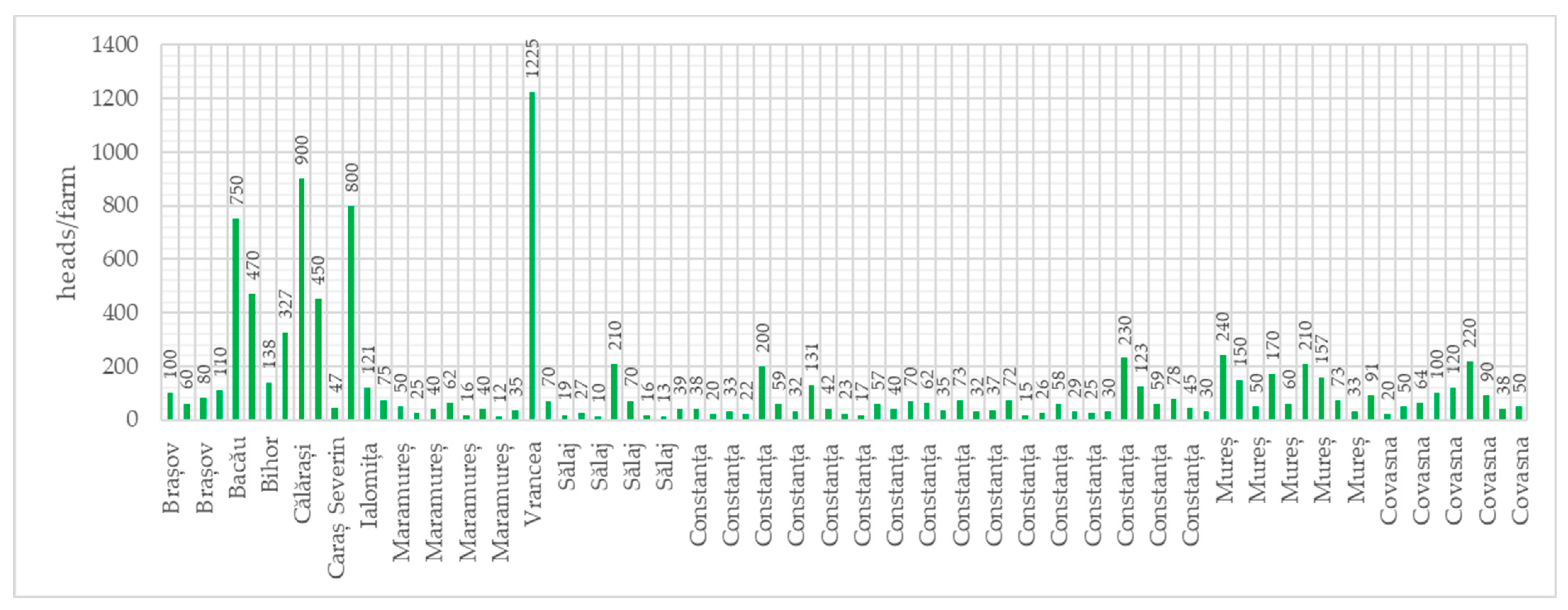
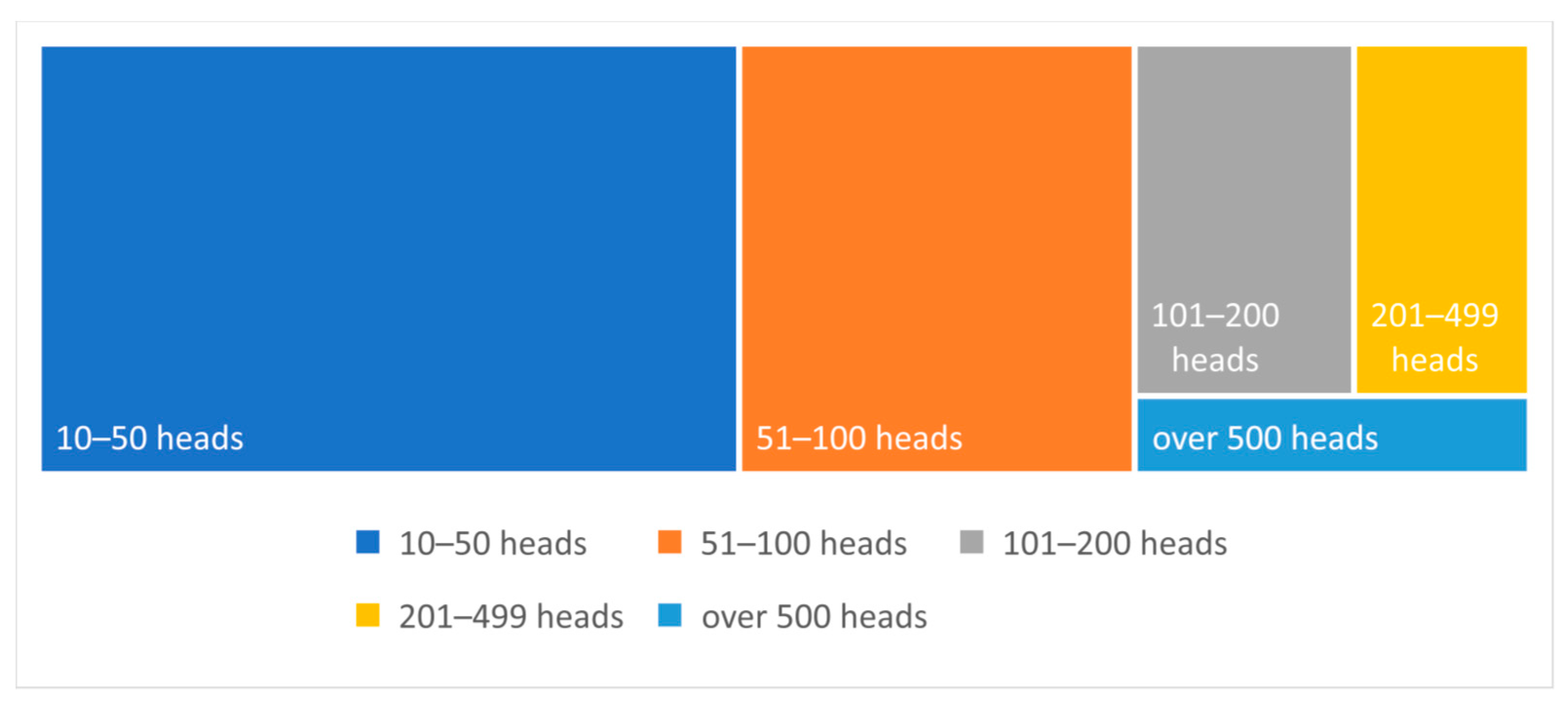
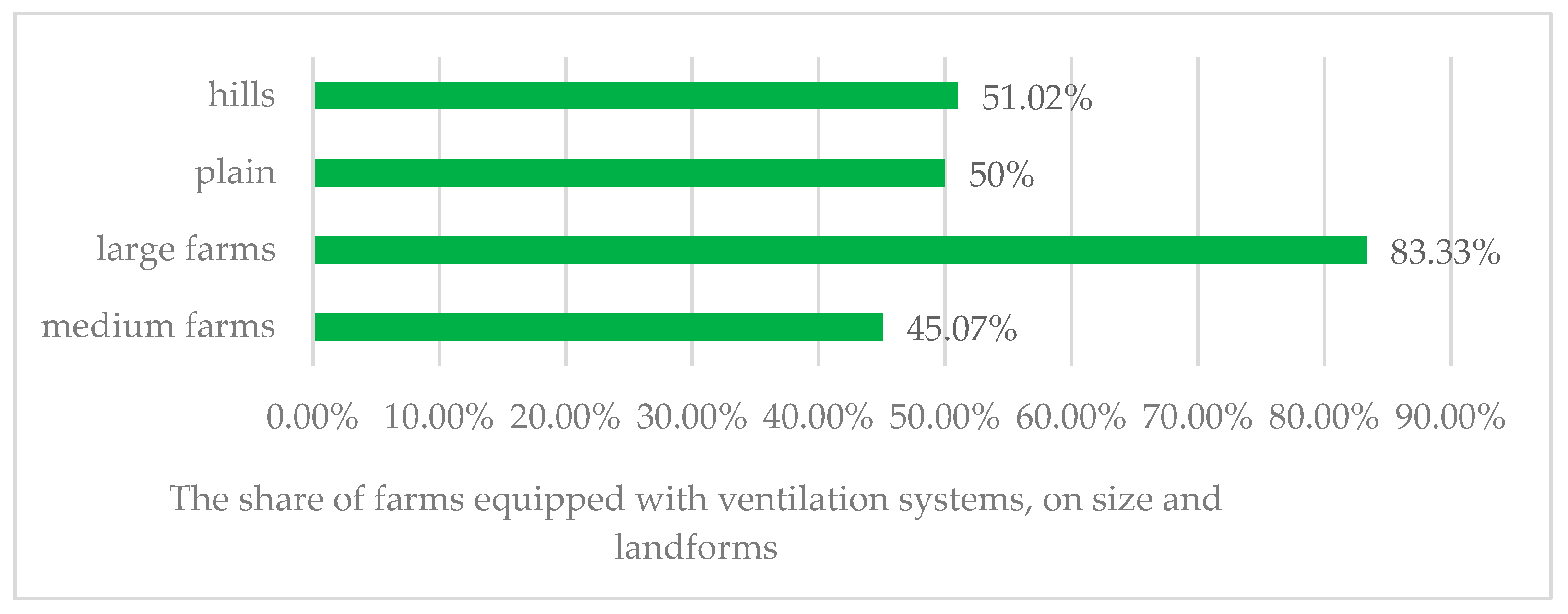
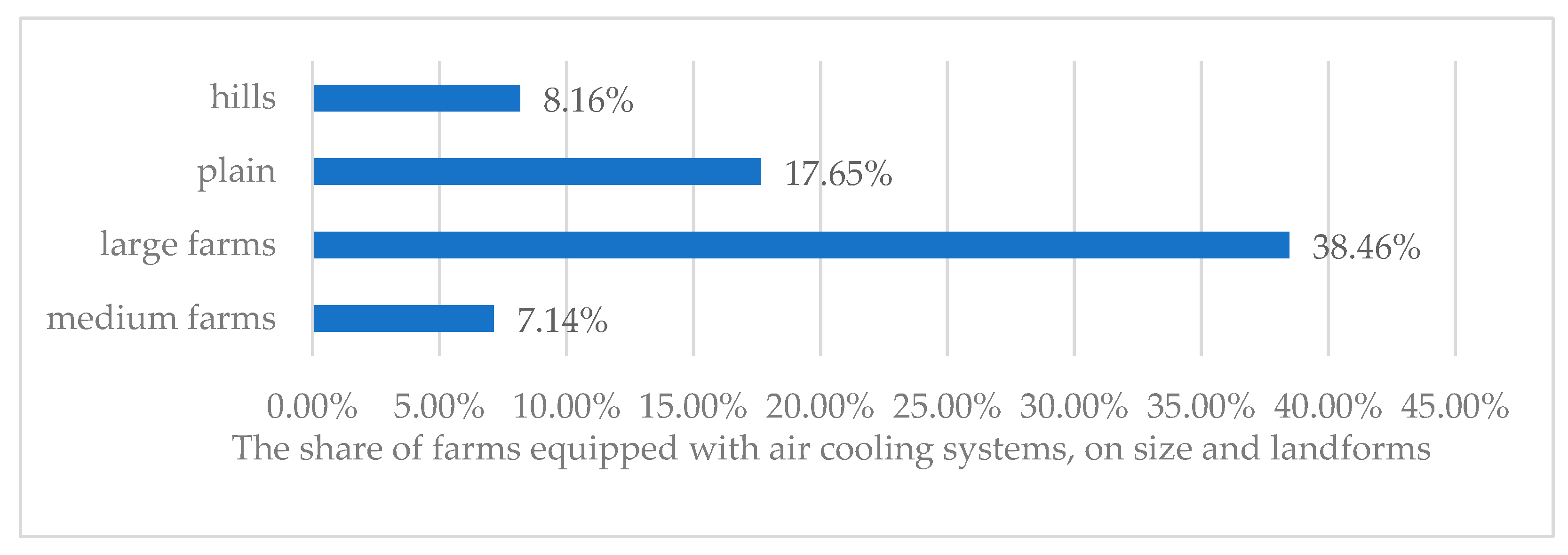




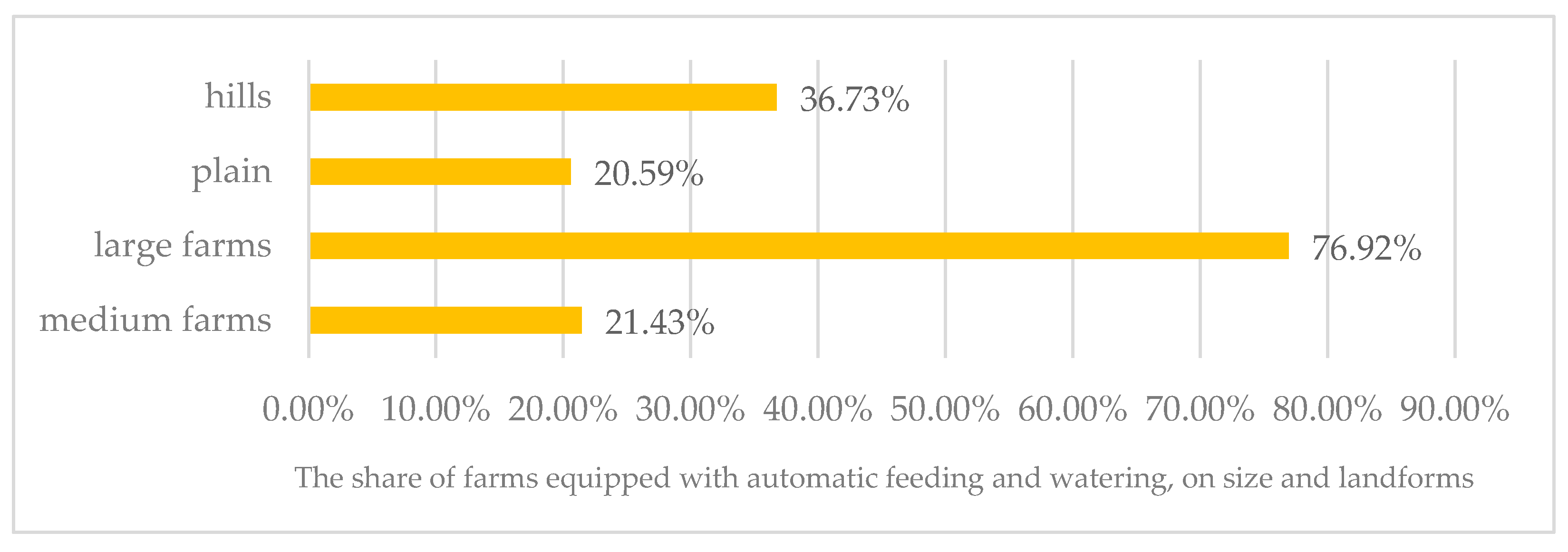
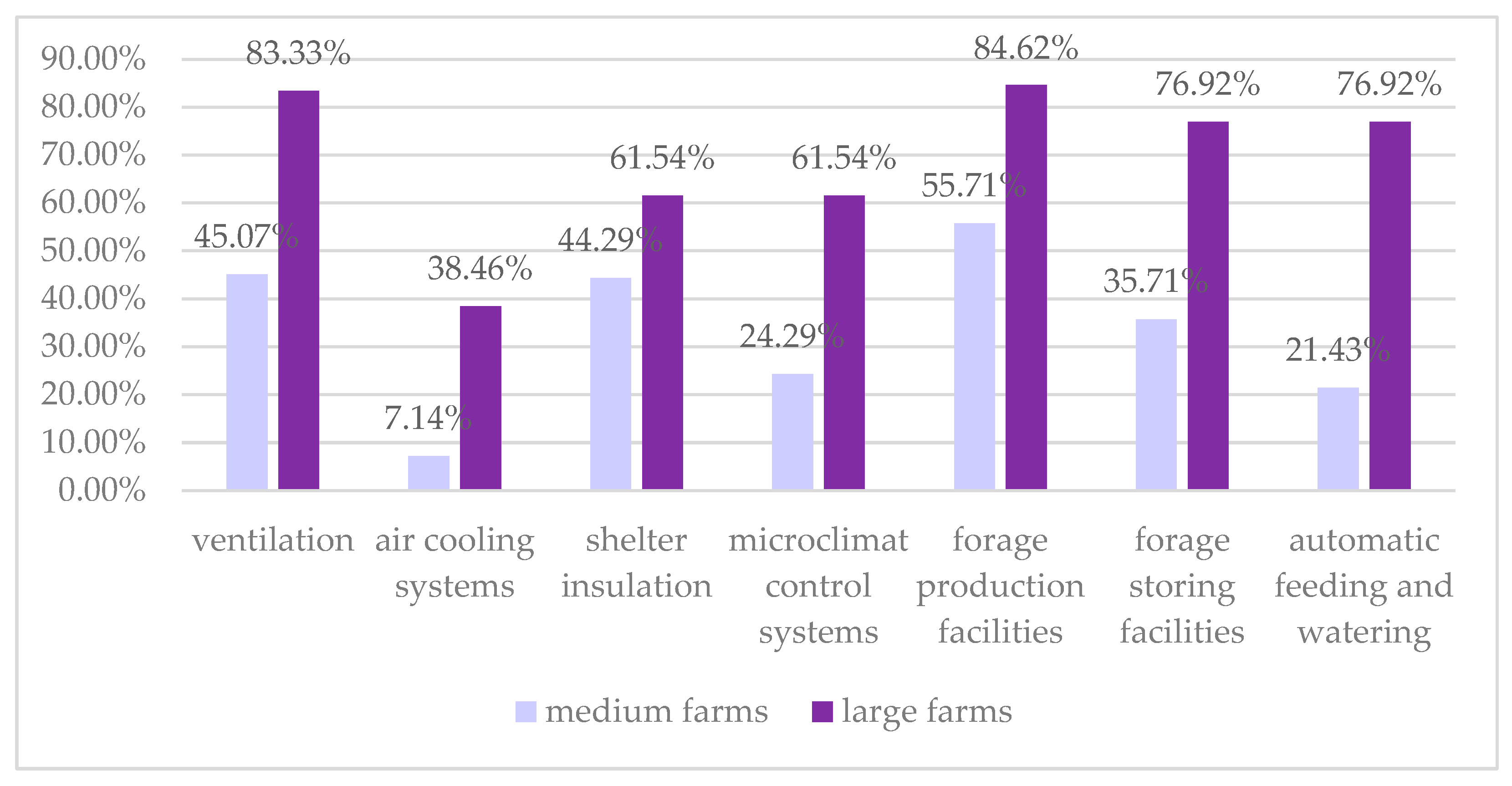

| Indicators | Measure Unit | Landform | Total | ||
|---|---|---|---|---|---|
| Plain | Hill and Plateau | ||||
| Number of farms | no. | 34 | 49 | 83 | |
| % | 40.96 | 59.04 | 100.00 | ||
| Heads | no. | 5872 | 4364 | 10,236 | |
| % | 57.37 | 42.63 | 100.00 | ||
| Farm size | Medium | no. | 27 | 43 | 70 |
| % | 38.57 | 61.43 | 84.34 | ||
| Large | no. | 7 | 6 | 13 | |
| % | 53.85 | 46.15 | 15.66 | ||
| Facility Types | Measure Unit | YES | NO |
|---|---|---|---|
| Ventilation in animal shelters | no. | 42 | 41 |
| % | 50.60 | 49.40 | |
| Air cooling systems in shelters | no. | 10 | 73 |
| % | 12.05 | 87.95 | |
| Shed insulation | no. | 39 | 44 |
| % | 46.99 | 53.01 | |
| Control of optimal microclimate parameters in shelters | no. | 25 | 58 |
| % | 30.12 | 69.88 | |
| Feed production lines | no. | 50 | 33 |
| % | 60.24 | 39.76 | |
| Feed storage silos | no. | 35 | 48 |
| % | 42.17 | 57.83 | |
| Automatic feeding | no. | 24 | 59 |
| % | 28.92 | 71.08 | |
| Automatic watering | no. | 37 | 46 |
| % | 44.58 | 55.42 |
| Criteria | Pearson Chi-Square | Critical Chi Value | Significance Level | df | Asymp. Sig. (2-Sided) |
|---|---|---|---|---|---|
| Existence of ventilation systems | |||||
| Farm size | 6.01 | 3.84 | 0.05 | 1 | 0.014 |
| Landform | 0.01 | 3.84 | 0.05 | 0.927 | |
| Air cooling systems | |||||
| Farm size | 11.61 | 10.83 | 0.001 | 1 | 0.001 |
| Landform | 1.70 | 3.84 | 0.05 | 0.192 | |
| Insulation of shelters | |||||
| Farm size | 0.72 | 3.84 | 0.05 | 1 | 0.395 |
| Landform | 0.00 | 3.84 | 0.05 | 0.991 | |
| Microclimate control systems | |||||
| Farm size | 5.30 | 3.84 | 0.05 | 1 | 0.021 |
| Landform | 0.14 | 3.84 | 0.05 | 0.712 | |
| Feed production lines in farms | |||||
| Farm size | 3.82 | 3.84 | 0.05 | 1 | 0.051 |
| Landform | 0.06 | 3.84 | 0.05 | 0.813 | |
| Equipment for storing forages | |||||
| Farm size | 7.63 | 3.84 | 0.05 | 1 | 0.006 |
| Landform | 5.82 | 3.84 | 0.05 | 0.016 | |
| Automatic feeding and watering | |||||
| Farm size | 16.38 | 13.82 | 0.001 | 2 | 0.0003 |
| Landform | 12.95 | 5.99 | 0.05 | 0.0015 | |
Disclaimer/Publisher’s Note: The statements, opinions and data contained in all publications are solely those of the individual author(s) and contributor(s) and not of MDPI and/or the editor(s). MDPI and/or the editor(s) disclaim responsibility for any injury to people or property resulting from any ideas, methods, instructions or products referred to in the content. |
© 2025 by the authors. Licensee MDPI, Basel, Switzerland. This article is an open access article distributed under the terms and conditions of the Creative Commons Attribution (CC BY) license (https://creativecommons.org/licenses/by/4.0/).
Share and Cite
Rodino, S.; Chetroiu, R.; Ilie, D.M.; Marin, A.; Dragomir, V.; Manolache, A.M.; Turek-Rahoveanu, P.A. Research on the Cattle Farm Endowments from the Climate Change Adapting Perspective. Agriculture 2025, 15, 1339. https://doi.org/10.3390/agriculture15131339
Rodino S, Chetroiu R, Ilie DM, Marin A, Dragomir V, Manolache AM, Turek-Rahoveanu PA. Research on the Cattle Farm Endowments from the Climate Change Adapting Perspective. Agriculture. 2025; 15(13):1339. https://doi.org/10.3390/agriculture15131339
Chicago/Turabian StyleRodino, Steliana, Rodica Chetroiu, Diana Maria Ilie, Ancuța Marin, Vili Dragomir, Alexandra Marina Manolache, and Petruța Antoneta Turek-Rahoveanu. 2025. "Research on the Cattle Farm Endowments from the Climate Change Adapting Perspective" Agriculture 15, no. 13: 1339. https://doi.org/10.3390/agriculture15131339
APA StyleRodino, S., Chetroiu, R., Ilie, D. M., Marin, A., Dragomir, V., Manolache, A. M., & Turek-Rahoveanu, P. A. (2025). Research on the Cattle Farm Endowments from the Climate Change Adapting Perspective. Agriculture, 15(13), 1339. https://doi.org/10.3390/agriculture15131339







